RZ -breeding success for health made in Germany
For the first time, German breeding organizations for the Holstein and Red Holstein cattle bring into use direct genomic health breeding values. According to these new relative genomic breeding values sires can be pointed out that inherit their resilience to their offspring. Animal health within the herd can be improved rapidly, effectively and accurately without missing performance.
The official breeding values for direct health traits for the Holstein breed will be published from now on, divided into five categories:
- RZudderfit with traits on clinical and subclinical mastitis
- RZhoof with traits on hoof diseases
- RZmetabol with traits for metabolic diseases
- RZrepro with traits for reproduction disorders
- RZhealth as total breeding value, in which all four values are weighted according to their economic importance
Overall, 13 different traits are implemented in these new breeding value indices. This was made possible due to several large-scale projects for genomic typing and collection of health data by farms in Germany. In accordance to that, collected data are optimally adapted to a wide variety of climates and farm structures.
The genomic breeding values are estimated with a reliability between 50 % and 60 % what is particularly high for health traits, showing the excellent quality of data and German breeding value estimation.
New from August 2019 RZcalfhealth for sustainable improvement of calf vitality and reduction of calf losses.
The breeding value RZhealth as an overall-index combines all four trait complex breeding values RZudderfit, RZhoof, RZrepro and RZmetabol. According to their economical importance they are weighted as followed:
- RZudderfit 40 %
- RZmetabol 25 %
- RZhoof 20 %
- RZrepro 15 %
By using the RZhealth index for selection breeding all 13 health traits that are part of the four relative breeding values can be improved simultaneously. Only one breeding index covers the diseases with the greatest impact. This is an important part of health prevention within herds. The reliability of 57 % proves the safety of this new genomic breeding value. The RZhealth provides excellent decision support for selection breeding and optimizes the health status of the entire herd. Are there any specific health problems in the herd, RZudderfit, RZhoof, RZmetabol and RZrepro can help choosing the appropriate bull for breeding.
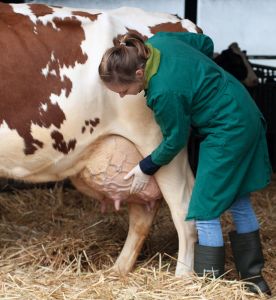
Mastitis is the disease with the greatest economical impact. A reduction of the mastitis rate brings financial and animal welfare benefits.
Mastitis still is the disease with the greatest economical impact. A clinical infection of mastitis during early lactation may cost up to 400 € to 600 € per animal for treatment and loss of milk revenue. Subclinical mastitis (diagnosed by increased somatic cells) costs up to 200 € per animal. Using the new genomic breeding value RZudderfit, the incidence of mastitis can now easily be reduced. The worldwide unique combination of health data representing early and late diseases and culling reasons shows exceptional positive effects: the reliability is 61 %! Focusing of RZudderfit during selection decisions the incidence of mastitis within herds can be decreased accurately and rapidly.
Milk performance is on healthy feet and that is what the new breeding value RZhoof stands for. This breeding value combines six important claw diseases with different weightings according to their economical impact:
- Dermatitis digitalis (Mortellaro) 30 %
- Sole ulcer 15 %
- Panaritium 15 %
- White line defect 15 %
- Laminitis 15 %
- Limax/Hyperplasia interdigitalis 10 %
The strong weighting of Mortellaro is no coincidence because the infectious disease currently spreads among herds. The RZhoof breeding value completes the actual breeding value DDcontrol by adding additional important traits for claw health. Consideration of the RZhoof breeding value during mating decisions is a positive step towards healthier feet within the herd. The reliability of the genomic RZhoof breeding value estimation is 51 %.
Only cows that become pregnant fast and easy stay in herd for many lactations. A vital reproductive system is essential for a long productive life. For the first time, this can be achieved by selection breeding using the genomic RZrepro breeding value. RZrepro takes into account reproductive disorders that occur during early (Uterine infection, Placental retention) or late lactation (Oestrus cycle disorders) and places them into economical appropriate weighting:
- Oestrus cycle disorders (e.g. cysts) 50 %
- Uterine infection 25 %
- Placental retention 25 %
Oestrus cycle disorders show a correlation to the feature complex dwell time
that is part of the relative breeding value daughter fertility (RZR) and therefore breeding efforts have already been undertaken. Data concerning the health features Uterine infection and Placental retention have not been sampled until yet – that’s a benefit of the new genomic relative breeding value RZrepro. Thanks to the new RZrepro and the data processed in it a focused selection breeding for fertile cattle is now possible. The reliability of the genomic breeding value estimation is 52 % what is very high for traits with low heritability.
Metabolic health is of major importance especially for high performance dairy cows, not only for economic reasons but also for animal welfare. Up to now, there were no useful auxiliary features for recording metabolic disorders and estimation of breeding values. In the genomic breeding value RZmetabol, for the first time, these traits with the following weightings are calculated into an index:
- Abomasal displacement 50 %
- Milk fever (Hypocalcemia) 25 %
- Ketosis 25 %
In the future the data basis of RZmetabol will increase significantly so that the reliability of the genomic breeding value will continue to rise. At the moment, the reliability is 55 %.
In order to improve the service life of our dairy cows, breeding values have been available for some time and these are used intensively for selection. For calves, however, there is only the breeding value for stillbirth rate, i.e. losses up to 48 h after birth. Until now, the rearing period has been a black hole
for breeding purposes. This changes in August 2019 with the official introduction of the breeding value for calf fitness, RZcalfhealth.
This breeding value describes the genetic ability to survive the rearing period from day 2 to the age of 15 months. As in the breeing value functional herd life for cows, the losses in calves at different ages are also caused by different diseases. Therefore the total timespan until 15 month of age is divided into 5 periods (day 3-14, 15-60, 61-120, 121-200, 201-458). With just under 2% heritability is not particularly high but genetic variability is considerable with ±3% mortality rate. The data basis is comprehensive and therefore the accuracy is good. The pure genomic RZcalfhealth has a accuracy of 51%.
Data is derived from the mandatory registration and traceability data for all cattle (HIT). Data of approx. 8 million female calves are the base of the breeding value estimate. Information from male calves is not used because most of them leave the dairy herd just after being two weeks old. The breeding value RZcalfhealth is expressed on the usual relative scale with 100 as the mean value and 12 as the genetic deviation. Higer values correspond to fewer calf losses. The mean value of 100 corresponds to approximately 93% to 15 months of survived animals, with 60% of the young animal losses occurring in the first two age segments up to 60 days.
Dr. Stefan Rensing, vit

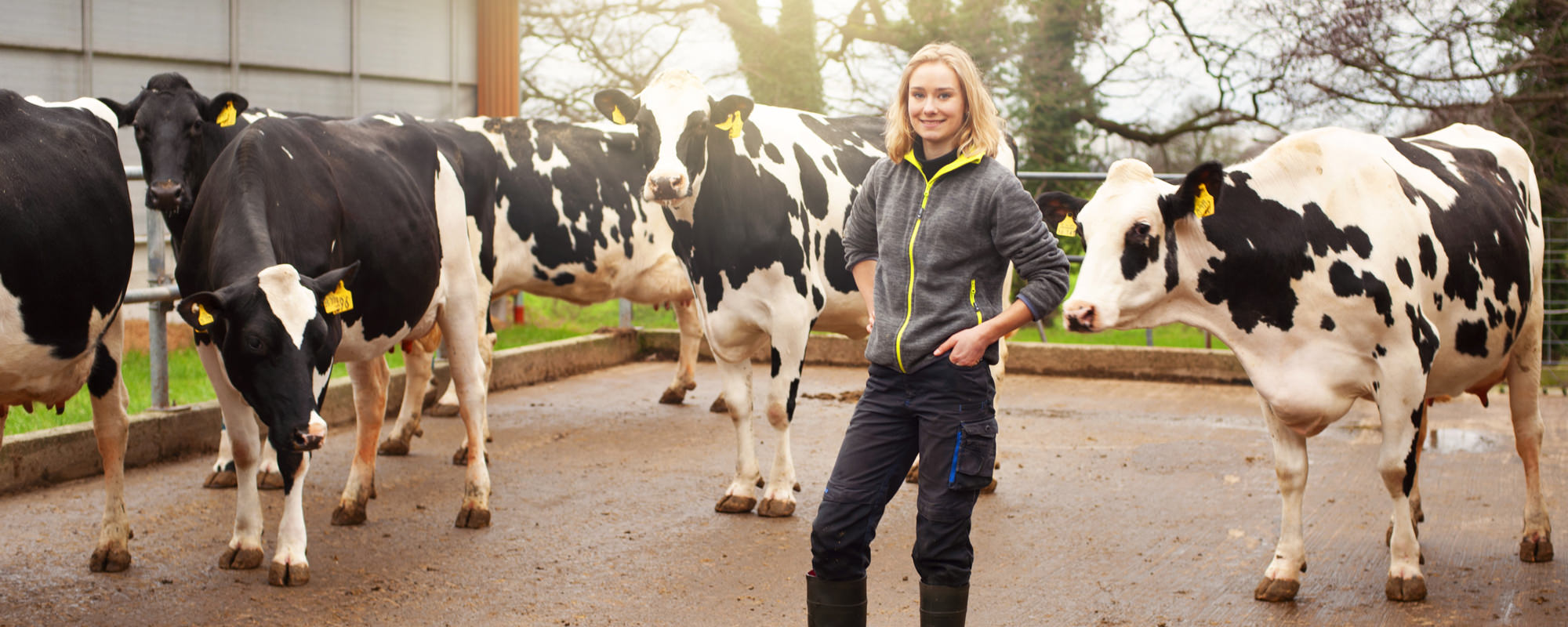
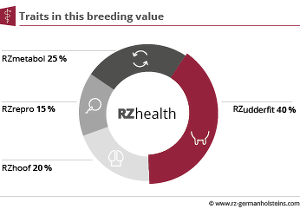
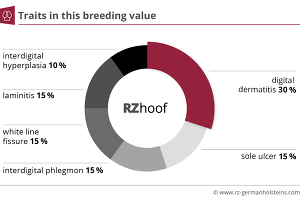
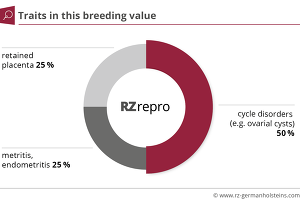
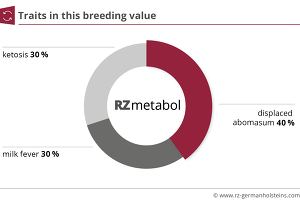
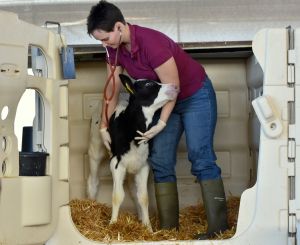










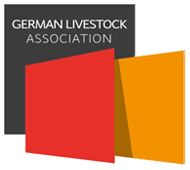 German Livestock Association
German Livestock Association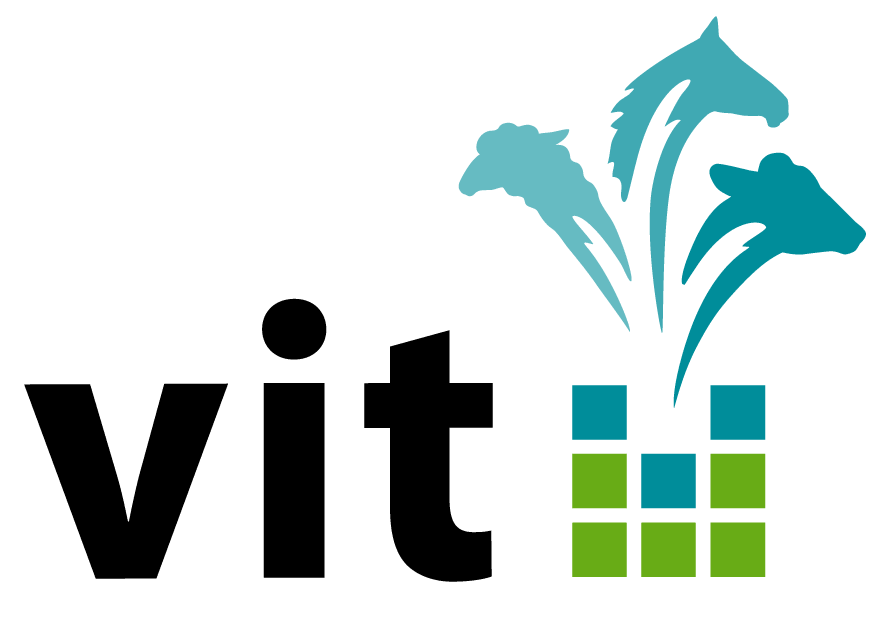 Vereinigte Informationssysteme Tierhaltung w.V.
Vereinigte Informationssysteme Tierhaltung w.V.